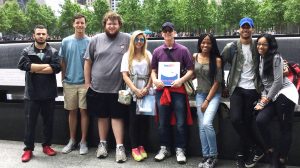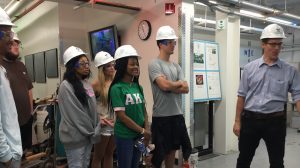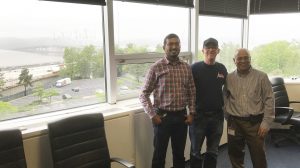
Christopher Mullen (center) stands with his students in front of the area where the World Trade Center’s Twin Towers once stood. Submitted photo
During May 2017 intersession, seven University of Mississippi civil engineering students ventured to New York City as enrollees of a new course titled “Bridges of New York.” The first offering proved to be an adventure in many respects for all involved.
“The idea for the course grew out of a bridge engineering course I taught the year before,” said Chris Mullen, UM associate professor of civil engineering. “I’d worked in Manhattan a number of years before beginning my academic career and thought that my excitement about the topic would be best shared and explored firsthand.”
Participant Tennant Duckworth agreed, finding it “a wonderful experience both in terms of academic knowledge and life experience.”
“Walking around the city helped to reinforce the topics covered in class,” he said. “Meeting with the various professionals and professors living and working in New York City was a great experience to gather a greater idea of the scope of the projects.”
The course was structured through a proposal submitted to UM’s Study USA program. After the idea was approved, a detailed agenda was mapped out with program director Laura Antonow, who had received her M.F.A. degree at Parsons School of Design in New York.
“It was decided to spend three days on campus preparing for the trip and a full week in New York City,” Mullen said. “While the focus would be on site visits to major bridges, time would be spent meeting with engineering professionals, with a number of museum visits and tours to provide cultural exposure.”
Before traveling, the class met for four hours each of the three days on campus to review structural engineering concepts related to bridge analysis, design, technology and maintenance. Textbook and assigned reading selections provided historical context and details of individual bridges, some of which the students visited.

UM engineering students listen as professor Andrew Smyth (right) gives them an overview of the Carleton Laboratory at Columbia University. Submitted photo
A variety of technical assignments were given including research on travel times to traverse multimodal transportation routes, design calculations for main cables of suspension bridges, live loads for locomotives, and influence lines for shear and moment in beam girders.
“After traveling on their own the night before, the class literally hit the ground running the first day,” Mullen said. “The class departed the hotel at 9 a.m., caught a subway from Grand Central Terminal to Brooklyn Bridge station, walked the milelong trek on the bike/pedestrian promenade across the bridge and down to Brooklyn Bridge Park and caught another subway that passed through a tunnel under the East River back to Manhattan.”
The group then listened to an hourlong presentation by young bridge project engineers in the offices of WAI, a major consulting firm located on Wall Street, caught yet another subway to Times Square, walked a half mile to Pier 83, took a one-and-a-half-hour Hudson and East River cruise on the Circle Line multilevel vessel around Lower Manhattan, passed under three historic East River suspension bridges, reversed their walk back to Times Square, passed the Port Authority bus terminal and returned to Grand Central Terminal and the hotel.
“The entire first day, they walked a total of over 20,000 steps in one day, according to one student’s fitness tracker,” Mullen said.
After the first day, the rest of the week flew by. The class became experts in subway travel by the third day and were able to enjoy many sites on their own at the end of each day including a number of museums.
The second day was a bit more relaxed and included a morning tour of the One World Observatory at the top of the Freedom Tower, which afforded views of all of Manhattan, the Hudson and East rivers, and the New York Bay, as well as the 9/11 Memorial and Museum, the newly completed Oculus and World Trade Center Transportation Hub, and the Tribeca Bridge.
“Visits to the George Washington and Tappan Zee bridges were spread over subsequent days,” Mullen said. “On route to the GWB, the class visited the main campus of Columbia University and received a guided tour of the Carleton Laboratory inside the

UM civil engineering professor Christopher Mullen (center) shares a moment with the project manager for the replacement of the Tappan Zee Bridge. Submitted photo
multistory engineering building.
The tour was led by a civil engineering professor who explained details of a unique test apparatus for a full-scale bridge cable, a moderate scale shake table he used for his research, and a loading machine capable of applying nearly a million pounds of force to bridge components.”
After lunch at Chelsea Market, the class traveled by chartered van to the New York Thruway Authority project office for the new New York (now Mario Cuomo) Bridge that carries Thruway traffic along a 3.2-mile crossing of the Hudson River. Weather prohibited access to the actual construction site, but the class saw a detailed presentation of the complete design and construction of the bridge including novel cost-saving techniques for prefabrication of deck and piers, delivery by river, and installation by dedicated derrick barge moored at the site.
“The final day was capped by a relaxed breakfast at the Princeton Club,” Mullen said. “Those who did (not) have morning flights were treated to an informal discussion with a world-class structural engineering expert who asked them some very challenging questions relating to the future of the profession.”